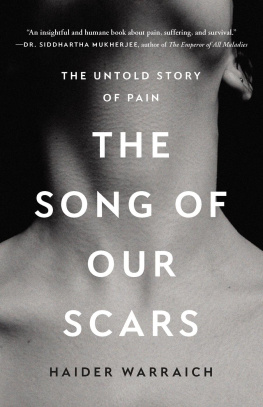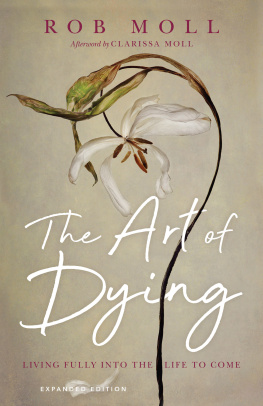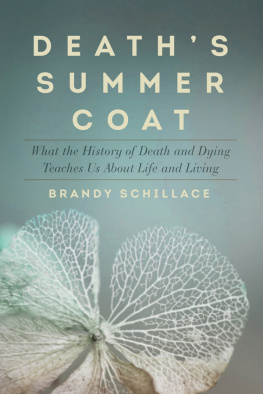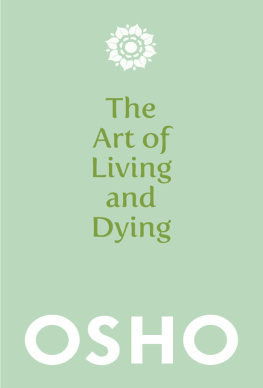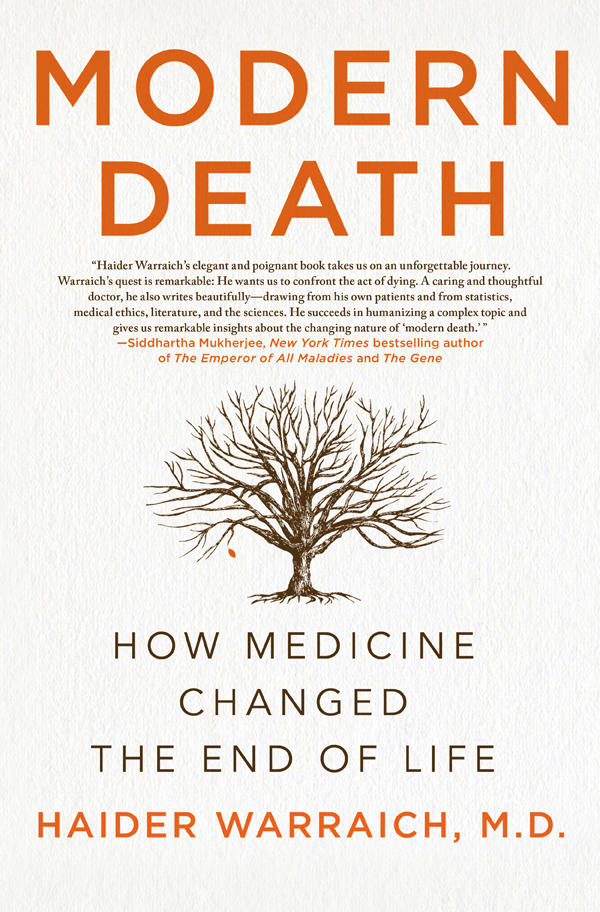The author and publisher have provided this e-book to you for your personal use only. You may not make this e-book publicly available in any way. Copyright infringement is against the law. If you believe the copy of this e-book you are reading infringes on the authors copyright, please notify the publisher at: us.macmillanusa.com/piracy.
To my wife, Rabail, for giving me the best years of my life
I was standing in a patients room as he lay in bed dying, surrounded by family members. I was the youngest person in the room, yet everyone was looking to me for answers. It was like they were at a restaurant where they couldnt read the menu and had never tasted the cuisine. They knew so much more about life than me, but so little about death. Thats when I decided that I wanted to write this book: for them and the countless others who let me be a part of the most agonizing moments of their lives. I also wrote it for myself and other healthcare providers, so that we would be better prepared to help.
I received a lot of inspiration at my hospital, the Beth Israel Deaconess Medical Center, in Boston, MA, where I was working when I wrote the book. It was there I learned what it took to deliver humane care. Much of what I know now to be true of what being a physician is, I learned there. Eileen Reynolds believed in me, offering me a spot in one of the most prestigious training programs in the country. I was selected to be a fellow in the Katherine Swan Ginsburg Fellowship in Humanism in Medicine, which was founded in the memory of Katherine Swan, a wonderful physician whose life was cut short at the age of thirty-four by cervical cancer. I never met Katherine, but I saw her humanity through her wonderful family, who continued her legacy through the program. It was during this time that I started to write regularly for the New York Times , where my editors including Toby Bilanow and Clay Risen, helped me improve my craft and reach an audience I could never have dreamed of.
Like anything in medicine though, it takes a small village to get anything done. This book has been no different. I presented the idea to my wife, who initially was skeptical. Between a busy medical training program and my research, it was ambitious to even think about writing a book. Yet as the words came and the stories formed, she gave me both the time and the confidence to keep going. I would come back from work and start writing in our tiny Boston apartment on our dining table for two. Without her, there would be no words, no pages, no chapters, and no book.
After I had written the book, I sought out an agent who would take a chance on a first-time author. I reached out to Don Fehr based on his previous work and though I had never met him, he got back to me within a day or so. He loved the manuscript and I knew my brief search was over.
I couldnt have found a better match in an editor than Daniela Rapp at St Martins Press. Not only was she interested in the material, she was personally invested in telling this story, which is what mattered most to me. Even before we dove into finding a publisher, Don had already indicated that Daniela would be a great editor for me to work with and he couldnt have been more right. The entire team at St Martins has been instrumental in making this process as streamlined and enjoyable as possible. I also have a lot of gratitude for all the wonderful authors who not only read the book but also offered their generous endorsements.
While I wrote the book in Boston, my new home at Duke University, in Durham, North Carolina, has been extremely supportive of my writing. Whether it is my faculty members within the Division of Cardiology and the Department of Medicine or the staff in communications, I have received my fair share of southern hospitality. These however are just some of the people who have been instrumental in helping turn this idea that I had on a solemn day in the hospital into a book that hopefully can tell one of the more important stories of our times.
It had been the longest of monthsin both the best and the worst possible ways. Brockton is a small town about a half-hour drive south of Boston, but in many ways it seems a world apart. As you move away from Boston, you can actually see rust accumulate on bridges, signboards, and fire hydrants. Boston carries a tasteful level of agedness, akin to a hint of silver hair. The red brick Federalist-style apartments of Back Bay, many built in the colonial period, have just the right amount of decay, which gives them a deep and rich texture. With Revival- and Georgian-style buildings intermixed, Boston is just rough enough to be photogenic. Brockton, on the other hand, is a town falling apart. Crooked goalposts stand half erect in fields with tall grass that might not have seen a game of football in decades. The town is awash in violent crime and drugs.
The town of Brockton is served by a community hospital that mirrors many of the characteristics of the town it is located in. Medicine residents from my program would go to the intensive-care unit (ICU) in that hospital for an away rotation, and it was an experience of legendary proportions. Unlike the large academic referral center we were used to, with an abundance of nurses and doctors, the Brockton ICU was run predominantly by the residents even though the patients there were sicker in many ways. In the primary hospital where I was training, there was a surgical ICU, a neurological ICU, a cardiac ICU, a trauma surgical ICU, and a bevy of medical ICUs, but there was only one ICU at Brockton, leaving the care of patients with a host of acute conditions in the hands of the medical residents and the supervising physician.
It was a Sunday, Super Bowl Sunday no less, and it was my last day in Brockton. The Patriots had lost the week before, so my interest was somewhat muted, but still, it was Super Bowl Sunday. I was scheduled to be there until seven in the evening and it would take me an hour to get back to Boston with the traffic, which would mean I would miss a large chunk of the game. But this Sunday was an almost miraculously quiet day. My team was done with rounds by noon, and we got no new patients afterward. It was so relaxed that I did the unthinkable: I asked my team who was going to be there overnight, whether I could call the shuttle early if we continued to have a quiet day. We had a deal. When the clock struck three, the ED was not buzzing, all our patients were well behaved, and there was no one headed up from the wards, so after checking again with the team, I called the shuttle service to come pick me up at five. I called my wife, ecstatic that I would be done early, and asked her to call our friends so that we could actually have the Super Bowl party she had so wanted to host.
It wasnt long after I hung up that my pager buzzed. There was a medical emergency on one of the wards. I picked up my stethoscope and shuffled toward where the emergency was. When I got there, the whole ward stank of human excrement. One of the nurses directed me toward a room outside which a large crowd had gathered. I made my way through the throng and found that there were three nurses in the bathroom struggling with a patient who didnt seem to be fully conscious. He was slouched over on the toilet seat, totally naked, and the entire bathroom floor was covered in black and bloody feces. The bathroom was very small, and the patient was at least six and a half feet tall and must have weighed at least three hundred pounds. The nurses were trying in vain to lift him up, while a few others were attempting unsuccessfully to get his bed into the bathroom. There was complete chaos, and no one had any idea what was going on.


